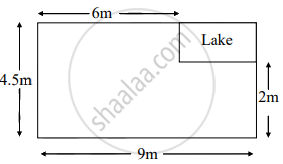Advertisements
Advertisements
प्रश्न
A card is drawn from well shuffled pack of 52 playing cards. Find the probability that the card drawn is a face card.
उत्तर
There are 52 cards.
n(S) = 52
Let 'A' be the event of getting face cards.
Event A: Getting face cards. There are 12 face cards in the pack of playing cards.
n (A) = 12
P(A) = `("n"("A"))/("n"("s"))`
P(A) = `12/52`
P(A) = `3/13`
APPEARS IN
संबंधित प्रश्न
The six faces of a die are marked
The event M is getting a vowel on the upper face of the die when it is tossed. Complete the following activity and find the probability of the event.
`"S" = {square}`
`"n"("S") = square`
`"M" = {square}`
`"n"("M") =square`
`"P"("M") = square/square=square`
If one die is rolled, then find the probability of event that the number on the upper face is greater than 6?
A missing helicopter is reported to have crashed somewhere in the rectangular region shown in the figure. What is the probability that it crashed inside the lake shown in the figure?
Using the digits 0, 2, 3, 5 the two-digit numbers are constructed without repetition of digits. Find the probability of the following events:
Condition for event A: The number formed is even.
A handbag contained fifty ten rupees note, thirty-five fifty rupees note and fifteen hundred rupee note. One note is drawn from a handbag. What is the probability of getting:
Ten rupees note
A handbag contained fifty ten rupees note, thirty-five fifty rupees note and fifteen hundred rupees note. One note is drawn from a handbag. What is the probability of getting:
Fifty rupees note
An urn contains 12 red balls, 15 yellow balls and 18 blue balls. A ball is choosen at random, then to find the probability of choosing a blue and red coloured balls, fill in the boxes.
Total number of balls = 12 + `square` + `square` = `square`
(1) Let E be the event that the choosen ball is blue.
Number of blue balls = `square`
Thus,
P(E) = `"Number of blue balls"/"Total number of balls"`
= `square/square`
(2) Let F be the event that the choosen ball is red.
Number of red balls = `square`
Thus,
P(F) = `square/"Total number of balls"`
= `square/square`
A five digit number is formed by the digits 1, 2, 3, 4, 5 without repetition. If the probability that the number formed is divisible by 4, is P, then 5P is ______.
A coin is tossed twice and the four possible outcomes are assumed to be equally likely. If A is the event, 'both head and tail have appeared' and B the event,' at most one tail is observed,' then the value of P(B/A) is ______.
A and B are events such that `P(A ∪ B)= 3/4`, `P(A ∩ B) = 1/4`, `P(overlineA) = 2/3` then `P(overlineA ∩ B)` is ______.
